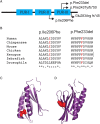Whole exome sequencing in family trios reveals de novo mutations in PURA as a cause of severe neurodevelopmental delay and learning disability
- PMID: 25342064
- PMCID: PMC4251168
- DOI: 10.1136/jmedgenet-2014-102798
Whole exome sequencing in family trios reveals de novo mutations in PURA as a cause of severe neurodevelopmental delay and learning disability
Abstract
Background: De novo mutations are emerging as an important cause of neurocognitive impairment, and whole exome sequencing of case-parent trios is a powerful way of detecting them. Here, we report the findings in four such trios.
Methods: The Deciphering Developmental Disorders study is using whole exome sequencing in family trios to investigate children with severe, sporadic, undiagnosed developmental delay. Three of our patients were ascertained from the first 1133 children to have been investigated through this large-scale study. Case 4 was a phenotypically isolated case recruited into an undiagnosed rare disorders sequencing study.
Results: Protein-altering de novo mutations in PURA were identified in four subjects. They include two different frameshifts, one inframe deletion and one missense mutation. PURA encodes Pur-α, a highly conserved multifunctional protein that has an important role in normal postnatal brain development in animal models. The associated human phenotype of de novo heterozygous mutations in this gene is variable, but moderate to severe neurodevelopmental delay and learning disability are common to all. Neonatal hypotonia, early feeding difficulties and seizures, or 'seizure-like' movements, were also common. Additionally, it is suspected that anterior pituitary dysregulation may be within the spectrum of this disorder. Psychomotor developmental outcomes appear variable between patients, and we propose a possible genotype-phenotype correlation, with disruption of Pur repeat III resulting in a more severe phenotype.
Conclusions: These findings provide definitive evidence for the role of PURA in causing a variable syndrome of neurodevelopmental delay, learning disability, neonatal hypotonia, feeding difficulties, abnormal movements and epilepsy in humans, and help clarify the role of PURA in the previously described 5q31.3 microdeletion phenotype.
Keywords: Clinical genetics; Developmental; Epilepsy and seizures; Neurology.
Published by the BMJ Publishing Group Limited. For permission to use (where not already granted under a licence) please go to http://group.bmj.com/group/rights-licensing/permissions.
Figures



Similar articles
-
A novel de novo mutation in the PURA gene associated with a new clinical finding: large brainstem.J Genet. 2020;99:7. J Genet. 2020. PMID: 32089526
-
Patient with a novel purine-rich element binding protein A mutation.Congenit Anom (Kyoto). 2017 Nov;57(6):201-204. doi: 10.1111/cga.12214. Epub 2017 Mar 24. Congenit Anom (Kyoto). 2017. PMID: 28164378
-
Expanding the phenotype of PURA-related neurodevelopmental disorder: a close differential diagnosis of infantile hypotonia with psychomotor retardation and characteristic facies.Clin Dysmorphol. 2021 Jan;30(1):1-5. doi: 10.1097/MCD.0000000000000360. Clin Dysmorphol. 2021. PMID: 33229923 Free PMC article.
-
PURA syndrome: clinical delineation and genotype-phenotype study in 32 individuals with review of published literature.J Med Genet. 2018 Feb;55(2):104-113. doi: 10.1136/jmedgenet-2017-104946. Epub 2017 Nov 2. J Med Genet. 2018. PMID: 29097605 Free PMC article. Review.
-
A new case with the recurrent PURA p.(Phe233del) pathogenic variant: Expansion of the phenotype and review of the literature.Int J Dev Neurosci. 2023 Jun;83(4):383-395. doi: 10.1002/jdn.10266. Epub 2023 May 19. Int J Dev Neurosci. 2023. PMID: 37204304 Review.
Cited by
-
"Yeah that Made a Big Difference!": The Importance of the Relationship between Health Professionals and Fathers Who Have a Child with Down Syndrome.J Genet Couns. 2018 Jun;27(3):665-674. doi: 10.1007/s10897-017-0171-y. Epub 2017 Nov 20. J Genet Couns. 2018. PMID: 29159544
-
Clinical and Pathologic Features of Congenital Myasthenic Syndromes Caused by 35 Genes-A Comprehensive Review.Int J Mol Sci. 2023 Feb 13;24(4):3730. doi: 10.3390/ijms24043730. Int J Mol Sci. 2023. PMID: 36835142 Free PMC article. Review.
-
Genetic architecture of childhood speech disorder: a review.Mol Psychiatry. 2024 May;29(5):1281-1292. doi: 10.1038/s41380-024-02409-8. Epub 2024 Feb 16. Mol Psychiatry. 2024. PMID: 38366112 Free PMC article. Review.
-
A novel de novo mutation in the PURA gene associated with a new clinical finding: large brainstem.J Genet. 2020;99:7. J Genet. 2020. PMID: 32089526
-
Case Report: Expanding the phenotypic spectrum of PURA syndrome in South America with the first presentation of concurrent vitiligo.Front Pediatr. 2024 Mar 28;12:1323014. doi: 10.3389/fped.2024.1323014. eCollection 2024. Front Pediatr. 2024. PMID: 38606370 Free PMC article.
References
-
- Van Bokhoven H. Genetic and epigenetic networks in intellectual disabilities. Annu Rev Genet 2011;45:81–104. - PubMed
-
- Ng SB, Bigham AW, Buckingham KJ, Hannibal MC, McMillin MJ, Gildersleeve HI, Beck AE, Tabor HK, Cooper GM, Mefford HC, Lee C, Turner EH, Smith JD, Rieder MJ, Yoshiura K-I, Matsumoto N, Ohta T, Niikawa N, Nickerson DA, Bamshad MJ, Shendure J. Exome sequencing identifies MLL2 mutations as a cause of Kabuki syndrome. Nat Genet 2010;42:790–3. - PMC - PubMed
-
- Hoischen A, van Bon BWM, Gilissen C, Arts P, van Lier B, Steehouwer M, de Vries P, de Reuver R, Wieskamp N, Mortier G, Devriendt K, Amorim MZ, Revencu N, Kidd A, Barbosa M, Turner A, Smith J, Oley C, Henderson A, Hayes IM, Thompson EM, Brunner HG, de Vries BBA, Veltman JA. De novo mutations of SETBP1 cause Schinzel-Giedion syndrome. Nat Genet 2010;42:483–5. - PubMed
-
- Vissers LELM, de Ligt J, Gilissen C, Janssen I, Steehouwer M, de Vries P, van Lier B, Arts P, Wieskamp N, del Rosario M, van Bon BWM, Hoischen A, de Vries BBA, Brunner HG, Veltman JA. A de novo paradigm for mental retardation. Nat Genet 2010;42:1109–12. - PubMed
-
- Ku CS, Polychronakos C, Tan EK, Naidoo N, Pawitan Y, Roukos DH, Mort M, Cooper DN. A new paradigm emerges from the study of de novo mutations in the context of neurodevelopmental disease. Mol Psychiatry 2013;18:141–53. - PubMed
Publication types
MeSH terms
Substances
Associated data
- Actions
Grants and funding
LinkOut - more resources
Full Text Sources
Other Literature Sources
Medical
Molecular Biology Databases
